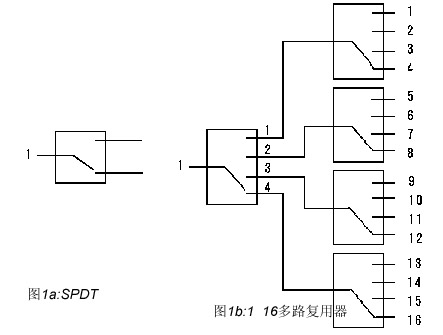Configure an optimal RF / microwave switch system
With the rapid growth of the communications industry, the test volume of the various components that make up these different communications systems has also grown tremendously. The test requirements and procedures for these products are quite different, and all tests must be performed at very high frequencies (above GHz). A typical test system mainly includes DC reference voltage, DC measurement, RF power meter, network analyzer, etc. Automating the test process and improving test efficiency require that RF / microwave and low-frequency switching systems be integrated into the test system.
The purpose of the switch is to transmit the signal from the measuring instrument to the device under test (DUT). Using switches, one instrument can measure multiple DUTs, and multiple instruments can also test one DUT through switches, or multiple instruments to test multiple DUTs. Therefore, the use of the switching system can automatically perform the test process.
This article briefly discusses several important aspects of configuring a high-frequency switching system, including system configuration and the selection of important switching indicators.
Switching system configuration
The switching system can be very simple or quite complex. For example, a single pole double throw switch (SPDT) can switch the signal to two different DUTs. It can be expanded to form a "multiplexer" configuration so that a single instrument can be switched to multiple different DUTs. It can also be multiple instruments to multiple DUTs. In this case, the switching system can be a multiplexer or a matrix, and only one signal can be transmitted at a time. Figure 1 shows the structure of an SPDT and a 1 × 16 multiplexer.

In order to increase the flexibility of the test, the switching system can connect multiple instruments with multiple DUTs. This is called the "blocking" configuration. At any time, any instrument can only be connected to one output. Figure 2 shows a 4 × 4 blocking switching system.

In order to switch any signal to any DUT at any time, you can use a non-blocking configuration (sometimes called a switch matrix). This switch configuration has high flexibility, but the cost is also the highest. Figure 3 shows a 4 × 4 non-blocking switch configuration, and Figure 4 shows an extended 4 × 6 switch configuration.


Choose important switch indicators
The use of switches will inevitably affect the performance of the measurement system, so it is important to consider several key parameters that can affect the performance of the system. There are two types of parameters to consider when configuring switches: electrical performance indicators and mechanical performance indicators.
Electrical performance indicators (1) Impedance matching: The switch is a set of instruments between the measuring instrument and the device under test. All impedances in the three systems (switch, measuring instrument, device under test) must match. For optimal signal transmission, the impedance of the source should be equal to the impedance of the switch and DUT. In RF testing, using different impedance levels can achieve different purposes. The most commonly used impedance level is 50Ω. For better power transfer, the impedance can be as low as 30Ω. To reduce the amount of RF signal attenuation, the typical impedance used is 75Ω. Regardless of the impedance level required, proper impedance matching will ensure the integrity of the entire system.
(2) Insertion loss: Any component on the signal transmission line will cause signal loss. Especially at higher frequencies or at resonance frequencies, the loss will be greater. When the signal is low or the noise is large, the insertion loss is a very important technical indicator. The insertion loss reflects the degree of attenuation of the actual power on the DUT compared to the source value of the test instrument. Generally, it is specified as a ratio of output power to input power at a certain frequency or within a frequency range.
InserTIon Loss (dB) =-10log (Pout / Pin)
(3) Channel isolation: At higher frequency points, signals transmitted on different channels will cause mutual interference due to capacitive coupling or electromagnetic radiation between the channels, which is called "crosstalk". When a weak signal channel is adjacent to a strong signal channel, crosstalk will have a great impact. In order to maintain sufficient isolation between signal channels, isolated measurements should be used.
(4) Voltage standing wave ratio (VSWR): Any component on the high-frequency signal channel will not only cause insertion loss, but also cause an increase in the standing wave on the signal transmission line. Standing waves are formed by the interference of transmitted electromagnetic waves and reflected waves. This interference is often caused by the impedance mismatch of different parts of the system or the impedance mismatch of the connection points in the system. Standing wave ratio is defined as the ratio of the highest voltage amplitude to the lowest voltage amplitude of the standing wave in the signal. In engineering, VSWR is often expressed as echo loss:
Return Loss (dB) =-20log [(VSWR-1) / (VSWR + 1)]
(5) Signal filter: In many cases, noise will inevitably be added to the transmitted signal, so the signal filter is very useful. If the original signal frequency is not suitable for the DUT test frequency, a filter can be added to the switch to eliminate noise or limit the bandwidth of the transmitted signal.
(6) Phase distortion: As the size of the test system expands, signals from the same signal source may be transmitted to the DUT through different channels. This indicator is often referred to as the transmission delay. For a given conductive medium, the delay is proportional to the signal path length. Different signal path lengths will cause the signal phase to shift. Phase shift can cause erroneous measurement results. Therefore, techniques that guarantee the same phase shift or the same transmission speed should be used to eliminate this effect.
(7) Reliability and repeatability: The reliability of the switch is an important factor. In general, a switching relay should have a life time of at least one million times; many relays have a life time of five million times.
Repeatability is the measurement of changes in insertion loss and phase shift when the switching system is used repeatedly. It is also an important factor.
Mechanical index
(1) Dimensions: This depends on the user's different applications. The switch dimensions may limit the choice of switch system. For a small switch, a small box is enough. For example, Keithley's 7999-4 microwave switch is a SPDT switch controlled by RS232, with a small metal frame. For a switching system with a medium number of signal paths, Keithley's 7001 system is a suitable choice. No matter how big the system is, a 700-slot 10-slot system may be needed.
(2) Connectors and cables: Many types of connectors and cables can be used in RF / microwave switch systems. When selecting connectors and cables, you should consider the signal frequency, system impedance, test fixture, and robot interface.
(3) Switch status display: When the system is established and debugged, the switch chassis should provide an LED display to indicate the on / off status.
Other relevant considerations
In addition to the electrical and mechanical specifications of the RF / microwave switching system, several factors that affect system performance need to be carefully considered.
(1) At high frequencies, all signals must be properly terminated, otherwise electromagnetic waves will be reflected from the termination point, resulting in an increase in VSWR. If the reflective part is large enough, it may even damage the source. In general, the coaxial cable used terminates the signal at 50Ω. For other types of communication systems, the signal is terminated at 75Ω.
(2) Bandwidth: Most switching system users want the bandwidth of the switch to be as wide as possible. However, wide bandwidth switches are relatively expensive. If a narrow bandwidth switch can achieve the same purpose, the cost will be significantly reduced. Another factor to consider is that when using high frequencies, the bandwidth depends on the connectors and cables used in the system. To ensure adequate system performance, high-performance connectors and cables are required.
(3) Power transmission: Another important consideration is the ability of the system to transmit RF power (from the instrument to the DUT). Due to insertion loss, the signal may need to be amplified. Sometimes, it may be necessary to reduce the power of the signal to the DUT. The use of amplifiers or attenuators ensures that accurate signal power values ​​are transmitted to the switching system.
About Silicone Door Stopper
As we know,there are many parents like to play with their children at home,and sometimes when they open the door will hit the child who is not flexible.At this time,they need a door stopper.And we have this kind of Silicone Door Stop ,And you can change its design and color.Just put the Silicone Door Stopper under the door that will better.
Made of high-quality Silicone,cute shape,Durable,solid design ensures years of use.So soft that won't scratch door,wall,floor,without scratching the floor and door surface like other metal stoppers.
This door stops will keep doors securely open,ensuring that your cat,dog,kids or baby remain safe from slamming doors.
Made from flexible silicone to easily wedge under doors without leave bad odor smells like other door stops.
There are many Silicone Door Stopper Wedge wanna recommend you such as Silicone Door Stopper for Baby, Baby Door Stopper ,Door Draft Stopper.
Product introduction:
1.Product name:Silicone Door Stop,Silicone Door Stopper,Silicone Door Stopper Wedge,Silicone Door Stopper for Baby,Baby Door Stopper,Door Draft Stopper
2.Place of origin:Guangdong China
3.Color:any pantone color
4.Effect:Any effect according to customer's requirement
5.MOQ:500pcs.
6.Package:1 pcs/opp,customized design is available.
7.Design:Customized/stock
8.Certification:FDA,LFGB,SGS,ROHS,etc.
9.Usage:To prevent doors from being accidentally closed and clamped onto the baby's hand
10.Silicone Door Stopper photos for reference.

Silicone Door Stopper
Silicone Door Stop,Silicone Door Stopper,Silicone Door Stopper Wedge,Silicone Door Stopper for Baby,Baby Door Stopper,Door Draft Stopper
OK Silicone Gift Co., Ltd. , https://www.oemsiliconegift.com
